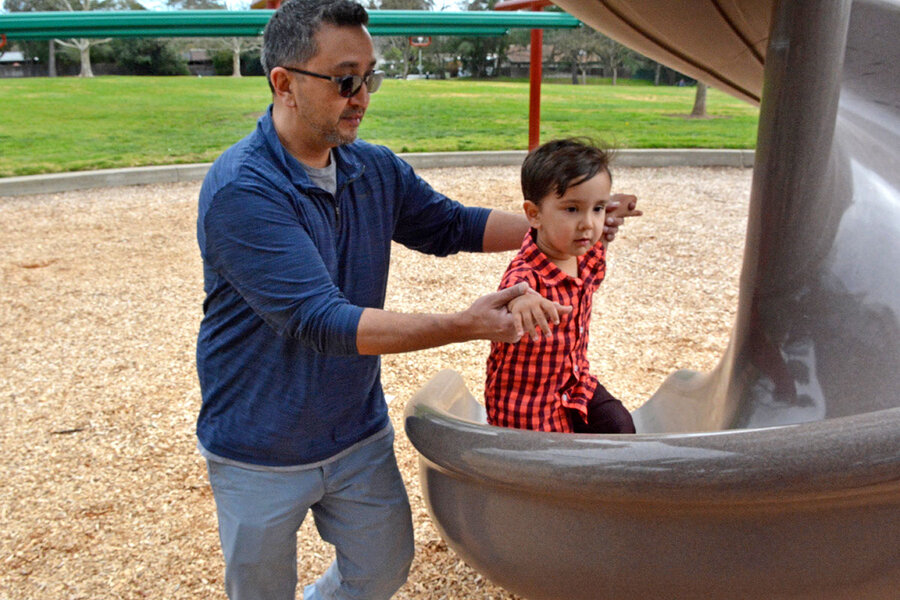For more US parents, paid family leave becomes reality
Loading...
| Carmichael, Calif.
In the United States, the only developed country without a national paid family leave policy, the idea is gaining ground – and men are taking advantage. Part of it is cultural, as more men take a larger role in raising their children. There’s also a generational shift, with more than 80 percent of Americans ages 18 to 29 supporting paternity leave compared with just over half of Americans older than 64. With a growing sense that the US is being left behind by a lack of family-friendly policies, and as more evidence shows that there are advantages to families when such programs are in place, there’s some movement at the federal and local levels, but states are driving change. In the past three years, New York, Washington State, and Washington, D.C., have passed legislation, and more than 20 are considering it. Murat Alptekin and his wife are each scheduling their paid leaves; their second baby is due in July. “She shouldn’t have to be the one to sacrifice everything,” says Mr. Alptekin. “There should be an opportunity for fathers to do the same and [contribute] towards the family.”
Why We Wrote This
California was the first state to provide paid family leave for workers, and in January, the state expanded its benefits. While economists are concerned about the burden on small businesses, one study found that 90 percent of businesses said it had no impact on profitability or productivity, while it had a positive impact on morale and turnover.
Murat Alptekin chases after his son at a community playground. Hair still damp from a recent swim lesson, 2-year-old Isa climbs up the nearest set of steps and races to the tallest slide, Mr. Alptekin right behind him. The pair stop by every few days to use the swings and spend time outside.
It’s clear father and son share a strong bond – one that Alptekin attributes to being able to take time off work the first few weeks after Isa was born. It was, Alptekin recalls, a “pretty hectic” time, with its mountains of diapers and sleepless nights. But he’s grateful, because he was able to be there for his son’s first, most important moments – without worrying about the bills.
And thanks to California’s progressive paid family leave program, he can do it all again when his second child is born in July. Without paid family leave, he says, “I’d have to take leave without pay, [and] that’s not an option now.”
Why We Wrote This
California was the first state to provide paid family leave for workers, and in January, the state expanded its benefits. While economists are concerned about the burden on small businesses, one study found that 90 percent of businesses said it had no impact on profitability or productivity, while it had a positive impact on morale and turnover.
Currently, California is one of four US states that provide paid family leave. But the idea is gaining ground – and men are taking advantage. Part of it is cultural, as gender norms shift and more men take a larger role in raising their children. There’s also a growing sense that the United States, and its female workforce, is being left behind. The nation is the only country in the 35-member Organization for Economic Co-operation and Development (OECD) without a national paid maternity leave policy, as more evidence emerges about the advantages to families when such programs are in place.
“Contrasting the US case with the OECD finds that it’s really the lack of access to family-friendly policies ... that’s holding women back [in the US labor market],” says Aparna Mathur, an economist with American Enterprise Institute. Paid family leave, she says, “tells you it’s OK to take that time off and come back – I think [that] is critical today in a generation where people are, in most cases, both parents working and there are lots and lots of responsibilities at home and at work.”
The drive has mostly taken place at the state level. In the past three years, New York, Washington State, and Washington, D.C., have passed paid family leave legislation, and more than 20 are considering legislation, including Colorado and Massachusetts. Those that already have programs in place are looking to take them further. New York, which implemented a paid family leave program in January, plans to extend the maximum time off from eight weeks in 2018 to 12 in 2021. California, which implemented paid family leave in 2004, recently expanded the benefits of the program, eliminating a seven-day waiting period before pay begins and increasing the wage replacement rate from 55 percent to between 60 percent and 70 percent depending on income.
Some cities are coming up with their own policies, too, independent of state laws. In San Francisco, for example, employees can now receive full pay during leave. The city ordinance, instituted in January, requires employers to fill in for the 40 percent of pay that the state program doesn’t cover.
There's a glimmer of movement at the federal level. In February, Sen. Marco Rubio (R) of Florida and Ivanka Trump were collaborating on a paid family leave proposal which would use Social Security benefits to pay for paid leave. “For the first time at the federal level we have at least proposals on both sides of the political aisle – they’re very different proposals – but that’s new,” says Christopher Ruhm, a professor of public policy and economics at the University of Virginia in Charlottesville.
“There’s a lot of momentum,” adds Ruth Milkman, a professor of sociology at the CUNY Graduate Center in New York. “Working people are really feeling the pinch of trying to balance out their family obligations with their paid work.”
More dads are opting in for paid family leave when they can get it. In California, Alptekin is one of about 77,152 men who took paid leave in 2017, double the number in 2009, according to numbers published by the California Employment Development Department. The surge is part of a generational shift in the way Americans view men’s role in the family: More than 80 percent of Americans ages 18 to 29 support paternity leave compared with just over half of Americans older than 64, according to a report by the Urban Institute.
“The new dads that are becoming dads now are just more likely to think they’re supposed to play a role,” says Jenya Cassidy, a project director at California Work & Family Coalition. “Paid leave itself is impacting it, but I think we’re also seeing a shift in how parenting happens because both parents work so often and they have to play that role, too, and they like to play that role.”
There’s evidence that family leave programs improve participation rates for mothers in the workforce, and labor market outcomes generally, Professor Ruhm says. The policy also extends the amount of time mothers have to breastfeed their children and increases bonding time for both parents, Ms. Cassidy says.
It’s also helpful financially. “I don’t have to wait the seven day period [to get paid], and that will help out,” Alpetkin says, “because last time I burned through a lot of vacation [hours].” Vacation hours can be used to supplement the partial pay to still obtain 40 hours of pay each week.
Still, some are concerned that low wage earners, for instance, may have less to gain than their middle- and high-earning counterparts. “Low wage workers are going to not be able to stay out of work for very long because they don’t think that [55 percent wage replacement] is a high enough amount,” says Dr. Mathur, referring to California's former wage replacement rate. Some may not even know the option is available to them: It’s estimated that 50 percent of residents don’t know they are eligible for taking the state leave, says Mathur.
Small-scale employers also say that the program is yet another requirement in California’s long list of regulations that make it hard to start and succeed in business in the state. “Small employers should have flexibility to work with their employees on health care, leave, and other programs that work best for their business,” says John Kabateck, California state director for the National Federation of Independent Business.
Some scholars say paid family leave has had little effect on businesses in general, especially as an employee payroll tax. In California, 90 percent of businesses said it had no impact on profitability, no impact on productivity, a positive impact on morale, and a positive impact on turnover, Professor Milkman finds.
As they prepare to welcome their second child, Alptekin and his wife are scheduling out who will take paid leave and when. It’s important to take on new challenges together, says Alptekin, and he likes being able to support his wife, her work, and their growing family. “She shouldn’t have to be the one to sacrifice everything … there should be an opportunity for fathers to do the same and [contribute] toward the family,” he says.
Editor's note: This story has been updated to reflect a more accurate number of men in California who took paid leave in 2017.









